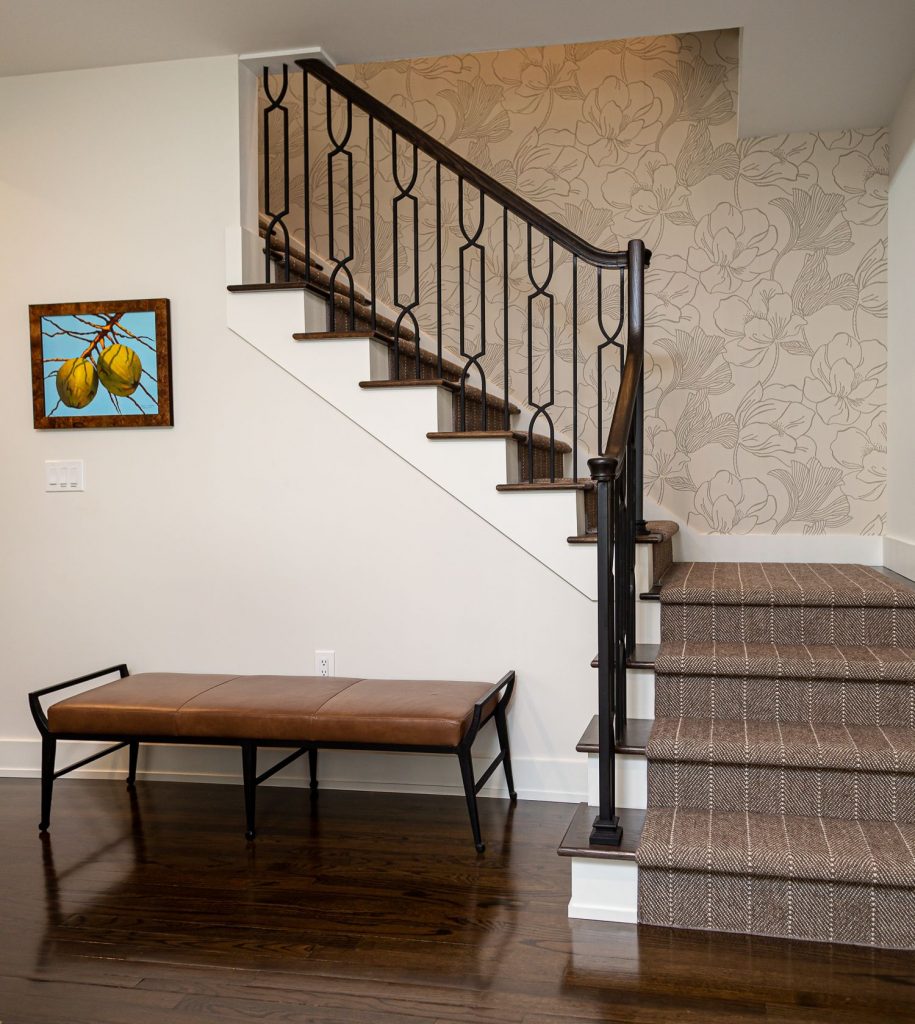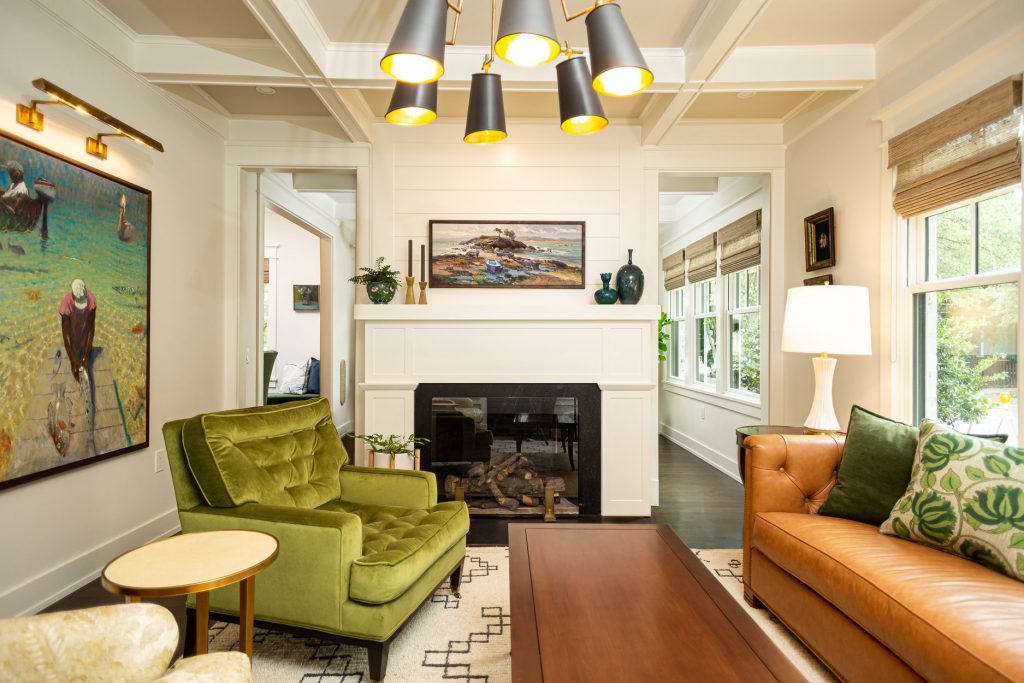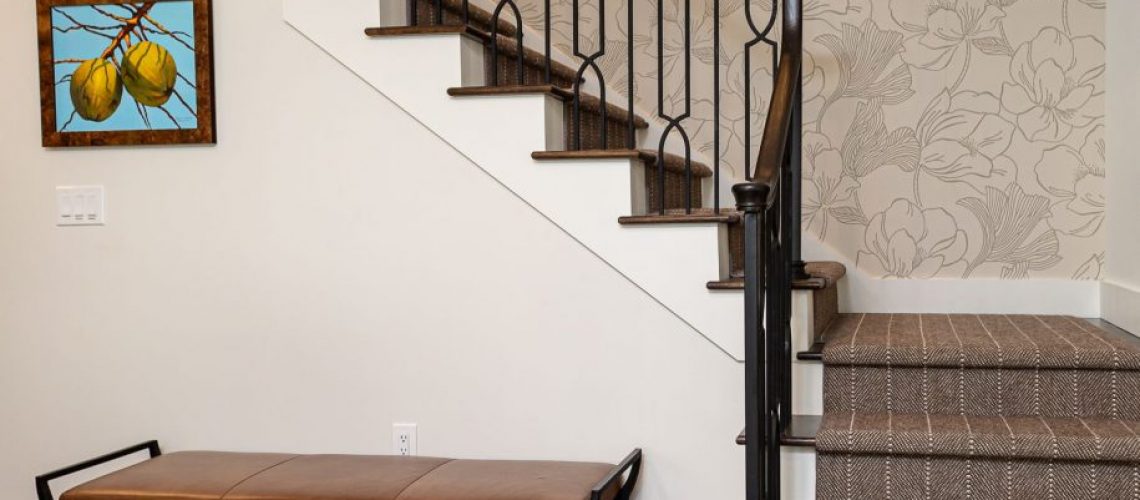
This St. Pete home we remodeled last year featured smooth finish walls. This made wallpaper application possible in the stairwell and other parts of the home.
Have you just moved to the Sunshine State from somewhere like California or New England? Then perhaps you are surprised by the number of homes that feature textured walls. Whether it’s the small, rough specks on a popcorn ceiling or orange-peel walls, or the more sweeping texture known as knock-down, texture can seem rough and strange when you’re used to smooth finish walls. So why do so many Florida homes have textured walls? And how do you make your walls smooth if you don’t like the texture? Read on to find out.
Reason Number 1 to Texture Walls: It is More Economical
Anyone who has installed and finished drywall knows that smooth-finish walls are very labor intensive. For the homeowner, this means it is more expensive. In order to understand this, you should understand that drywall finishing has been categorized into different levels:
- Level 0 Drywall Finish: No finishing of any kind has been done. Drywall sheets have been hung, and that’s it.
- Level 1: Joints have been taped, nothing more. This may be used in a garage, workshop, or a space that will never be seen.
- Level 2: There is a skim coat of joint compound over the tape, and drywall screw holes have been covered.
- Level 3: A coat of joint compound is applied over tape and screws. If the wall is to be textured, stopping at Level 3 would be sufficient.
- Level 4: A standard drywall finish, meaning a third coat of joint compound is applied, and the wall is sanded when the compound is dry.
- Level 5: The highest level of drywall finish, which involves applying another skim coat and sanding until the wall is perfect. Level 5 finish should be applied if the final paint will be high-gloss, or if the lighting is such that imperfections in the wall would be highlighted.
As you can see, a smooth-finish wall (Level 4 or 5) means that you are applying more layers of drywall mud and sanding and re-finishing until it is perfectly smooth. When we do Level 5 finish in our homes at Nelson Construction and Renovations, we use a high-powered halogen light to ensure there are no areas of imperfection. In essence, this means more man-hours, more materials – and thus, a higher cost than just spraying texture on a level 3 wall.
Reason Number 2 to Texture Walls: It Hides Imperfections
Anyone with any experience painting walls understands how much easier it is to paint a textured wall versus a smooth-finish wall. On a textured wall, paint touch-ups are as simple as dabbing a few brush marks on a damaged area – whereas you pretty much have to re-paint the entire wall if it is smooth finish, to avoid lines and spots.
This can be very desirable for a homeowner wanting low maintenance walls. This is also desirable for an investor wanting to flip a home fast. However, when it comes to a high-end, luxury home, where your wall finish can make or break a room, texture is the last thing you want.

We did a smooth finish on the walls of this St. Pete home when we did a full gut and remodel on it last year.
How to Make Your Walls Smooth
If you are building a new home from the ground up, the formula is very simple: tell your contractor you want Level 5 finish on your walls (or Level 4, if you can tolerate some imperfections). If you are renovating an existing home, however, this process will be more involved (and thus more expensive). Your contractor will have to:
- Apply a bonding agent over the texture (since you now have to apply drywall mud over paint);
- Apply a skim coat of joint compound over the texture (we recommend using all-purpose mud, not hot mud);
- Let it dry, at which point the joint compound will shrink;
- Apply another coat of joint compound;
- Sand thoroughly;
- And so on and so forth, layering it on like an onion, until the texture is completely encapsulated.
- (If you are dealing with a popcorn ceiling, this requires even more labor, as you have to remove the popcorn before applying smooth finish.)
The above work does require a drywall finishing or plaster expert, as there are many specifics to the application process that only a professional and experienced drywall technician will understand.
Fun Fact: If you have asbestos in your walls, you can safely encapsulate it using the above process! It will completely seal your wall and keep you and your family safe.
As you can see, creating smooth walls in your home is not the fast and easy way to go – but it does, in our opinion, create an aesthetic ambiance that is inimitable.
Nelson Construction and Renovations, a family business founded in 2006, is a design-build company that specializes in high-end remodels, home additions, and custom homes. With our headquarters in Clearwater, Florida, we serve homeowners all over Pinellas and Hillsborough Counties. We are an award-winning member of the National Association of the Remodeling Industry and have an A+ rating with the Better Business Bureau.
Creative Commons Attribution: Permission is granted to re-post this article in its entirety with credit to Nelson Construction and a clickable link back to this page.
The post Why Do Florida Homes Have Textured Walls, and How Do I Make My Walls Smooth? appeared first on Nelson Construction & Renovations, Inc..
